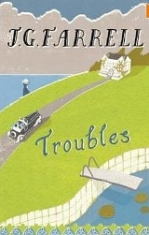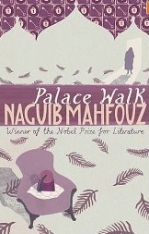What I'm Reading: Conductor Peter Phillips | reviews, news & interviews
What I'm Reading: Conductor Peter Phillips
What I'm Reading: Conductor Peter Phillips
The founder of the Tallis Scholars picks J G Farrell and Naguib Mahfouz
Next to choose some favourite books is conductor Peter Phillips, whose touring lifestyle can make "summer reading" something of a year-round phenomenon. When Phillips founded the vocal ensemble the Tallis Scholars in 1973 it was a hobby among university friends – a “haphazard” group, as the director himself describes it. Decades later, with more than 1,000 concerts and 50 disks to their credit, both the group and its members have grown up into professionals at the head of their field.
Specialising in Renaissance polyphony at a time when such music was not only unfashionable but almost entirely unknown, Phillips was one of the first to introduce audiences to this rich seam of repertoire that has since gained such a central place in concert halls and recordings.
When not at the helm of the Tallis Scholars, Phillips works with international ensembles that have included the Finnish Radio Choir, the BBC Singers and the Netherlands Chamber Choir, as well as writing regularly on music for The Spectator. Most recently he was appointed Director of Music at Merton College, Oxford.
I'm reading the Lost Booker Prizewinner from 1970, J G Farrell's Troubles – it is brilliantly written. Set in Ireland in a fading hotel the size of Gormenghast, with endless rooms, we see the hotel gradually collapsing as the British rule in Ireland in 1919 is collapsing. The hero means to leave but somehow never quite manages it. [Extract from Troubles by J G Farrell (1970)]
[Extract from Troubles by J G Farrell (1970)]
In those days the Majestic was still standing in the Kilnalough at the very end of a slim peninsula covered with dead pines leaning here and there at odd angles. At that time there were probably yachts there too during the summer since the hotel held a regatta every July. These yachts would have been beached on one or other of the sandy crescents that curved out towards the hotel on each side of the peninsula. But now both pines and yachts have floated away and one day the high tide may very well meet over the narrowest part of the peninsula, made narrower by erosion. As for the regatta, for some reason it was discontinued years ago, before the Spencers took over the management of the place. And a few years later still the Majestic itself followed the boats and preceded the pines into oblivion by burning to the ground – but by that time, of course, the place was in such a state of disrepair that it hardly mattered.
Curiously, in spite of the corrosive effects of the sea air the charred remains of the enormous main building are still to be seen; for some reason – the poor quality of the soil or the proximity to the sea – vegetation has only made a token attempt to possess them. Here and there among the foundations one might still find evidence of the Majestic's former splendour: the great number of cast-iron bathtubs, for instance, which had tumbled from one blazing floor to another until they hit the earth; twisted bed-frames also, some of them not yet altogether rusted away; and a simply progidious number of basins and lavatory bowls. At intervals along the outer walls there is testimony to the stupendous heat of the fire: one can disinter small pools of crystal formed in layers like the drips of wax from a candle, which gathered there, of course, from the melting of the windows. Pick them up and they separate in your hand into the cloudy drops that formed them.
Another curious thing: one comes across a large number of tiny white skeletons scattered round about. The bones are very delicate and must have belonged, one would have thought, to small quadrupeds... (“But no, not rabbits,” says my grandfather with a smile.)
- Find Troubles on Amazon
The Cairo Trilogy – a triptych of novels by the Egyptian writer and Nobel Prize-winner Naguib Mahfouz. They were given to me in 1993. Mahfouz is writing about the Egyptian Revolution in the 1920s, the throwing out of British rule once again. He gives you a picture of an entire society - rather like Anthony Powell's A Dance to the Music of Time - but where Powell is more stand-offish, more of an observer, Mahfouz is much more involved. It's all about the details: the way the patriarch runs his family, the way his wife gets up early each morning to bake bread. [Extract from Palace Walk by Naguib Mahfouz (1956)]
[Extract from Palace Walk by Naguib Mahfouz (1956)]
She woke at midnight. She always woke up then without having to rely on an alarm clock. A wish that had taken root in her awoke her with great accuracy. For a few moments she was not sure she was awake. Images from her dreams and perceptions mixed together in her mind. She was trouble by anxiety before opening her eyes, afraid sleep had deceived her. Shaking her head gently, she gazed at the total darkness of the room. There was no clue by which to judge the time. The street noise outside her room would continue until dawn. She could hear the babble of voices from the coffeehouses and bars, whether it was early evening, midnight, or just before daybreak. She had no evidence to rely on except her intuition, like a conscious clock hand, and the silence encompassing the house, which revealed that her husband had not yet rapped at the door and that the tip of his stick had not yet struck against the steps of the staircase.
Habit woke her at this hour. It was an old habit she had developed when young and it had stayed with her as she matured. She had learned it along with the other rules of married life. She woke up at midnight to await her husband's return from his evening's entertainment. Then she would serve him until he went to sleep. She sat up in bed resolutely to overcome the temptation posed by sleep. After invoking the name of God, she slipped out from under the covers and onto the floor. Groping her way to the door, she guided herself by the bedpost and a panel of the window. As she opened the door, faint rays of light filtered in from a lamp set on a bracketed shelf in the sitting room. She went to fetch it, and the glass projected onto the ceiling a trembling circle of pale light hemmed in by darkness. She placed the lamp on the table by the sofa. The light shone throughout the room, revealing the large, square floor, high walls, and ceilings with parallel beams. The quality of the furnishings was evident: the Shiraz carpet, large brass bed, massive armoire, and long sofa draped with a small rug in a patchwork design of different motifs and colours.
- Find The Cairo Trilogy on Amazon
- Peter Phillips directs the Tallis Scholars at Cadogan Hall on 12 October
- Learn more about the Tallis Scholars and their forthcoming projects
- Follow Peter Phillips' thoughts on his blog
- What I'm Reading: other guests include ballerina Tamara Rojo, songwriter Tom Russell, theatre designer Tobias Hoheisel, sculptor Cornelia Parker, musician Mike Scott, dramatist Patrick Marber, dancer Carlos Acosta, author Tibor Fischer
Share this article
more Classical music
 Christian Pierre La Marca, Yaman Okur, St Martin-in-The-Fields review - engagingly subversive pairing falls short
A collaboration between a cellist and a breakdancer doesn't achieve lift off
Christian Pierre La Marca, Yaman Okur, St Martin-in-The-Fields review - engagingly subversive pairing falls short
A collaboration between a cellist and a breakdancer doesn't achieve lift off
 Ridout, Włoszczowska, Crawford, Lai, Posner, Wigmore Hall review - electrifying teamwork
High-voltage Mozart and Schoenberg, blended Brahms, in a fascinating programme
Ridout, Włoszczowska, Crawford, Lai, Posner, Wigmore Hall review - electrifying teamwork
High-voltage Mozart and Schoenberg, blended Brahms, in a fascinating programme
 Sabine Devieilhe, Mathieu Pordoy, Wigmore Hall review - enchantment in Mozart and Strauss
Leading French soprano shines beyond diva excess
Sabine Devieilhe, Mathieu Pordoy, Wigmore Hall review - enchantment in Mozart and Strauss
Leading French soprano shines beyond diva excess
 Špaček, BBC Philharmonic, Bihlmaier, Bridgewater Hall, Manchester review - three flavours of Vienna
Close attention, careful balancing, flowing phrasing and clear contrast
Špaček, BBC Philharmonic, Bihlmaier, Bridgewater Hall, Manchester review - three flavours of Vienna
Close attention, careful balancing, flowing phrasing and clear contrast
 Watts, BBC Symphony Orchestra and Chorus, Bignamini, Barbican review - blazing French masterpieces
Poulenc’s Gloria and Berlioz’s 'Symphonie fantastique' on fire
Watts, BBC Symphony Orchestra and Chorus, Bignamini, Barbican review - blazing French masterpieces
Poulenc’s Gloria and Berlioz’s 'Symphonie fantastique' on fire
 Bell, Perahia, ASMF Chamber Ensemble, Wigmore Hall review - joy in teamwork
A great pianist re-emerges in Schumann, but Beamish and Mendelssohn take the palm
Bell, Perahia, ASMF Chamber Ensemble, Wigmore Hall review - joy in teamwork
A great pianist re-emerges in Schumann, but Beamish and Mendelssohn take the palm
 First Persons: composers Colin Alexander and Héloïse Werner on fantasy in guided improvisation
On five new works allowing an element of freedom in the performance
First Persons: composers Colin Alexander and Héloïse Werner on fantasy in guided improvisation
On five new works allowing an element of freedom in the performance
 First Person: Leeds Lieder Festival director and pianist Joseph Middleton on a beloved organisation back from the brink
Arts Council funding restored after the blow of 2023, new paths are being forged
First Person: Leeds Lieder Festival director and pianist Joseph Middleton on a beloved organisation back from the brink
Arts Council funding restored after the blow of 2023, new paths are being forged
 Classical CDs: Nymphs, magots and buckgoats
Epic symphonies, popular music from 17th century London and an engrossing tribute to a great Spanish pianist
Classical CDs: Nymphs, magots and buckgoats
Epic symphonies, popular music from 17th century London and an engrossing tribute to a great Spanish pianist
 Sheku Kanneh-Mason, Philharmonia Chorus, RPO, Petrenko, RFH review - poetic cello, blazing chorus
Atmospheric Elgar and Weinberg, but Rachmaninov's 'The Bells' takes the palm
Sheku Kanneh-Mason, Philharmonia Chorus, RPO, Petrenko, RFH review - poetic cello, blazing chorus
Atmospheric Elgar and Weinberg, but Rachmaninov's 'The Bells' takes the palm
 Daphnis et Chloé, Tenebrae, LSO, Pappano, Barbican review - lighting up Ravel’s ‘choreographic symphony’
All details outstanding in the lavish canvas of a giant masterpiece
Daphnis et Chloé, Tenebrae, LSO, Pappano, Barbican review - lighting up Ravel’s ‘choreographic symphony’
All details outstanding in the lavish canvas of a giant masterpiece
 Goldscheider, Spence, Britten Sinfonia, Milton Court review - heroic evening songs and a jolly horn ramble
Direct, cheerful new concerto by Huw Watkins, but the programme didn’t quite cohere
Goldscheider, Spence, Britten Sinfonia, Milton Court review - heroic evening songs and a jolly horn ramble
Direct, cheerful new concerto by Huw Watkins, but the programme didn’t quite cohere

Add comment